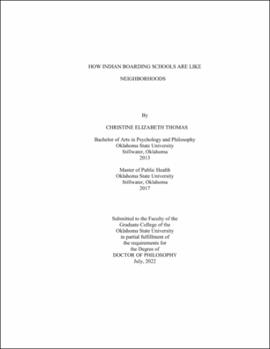| dc.contributor.advisor | Sittner, Kelley J. | |
| dc.contributor.author | Thomas, Christine Elizabeth | |
| dc.date.accessioned | 2023-04-05T16:21:25Z | |
| dc.date.available | 2023-04-05T16:21:25Z | |
| dc.date.issued | 2022-07 | |
| dc.identifier.uri | https://hdl.handle.net/11244/337331 | |
| dc.description.abstract | Contemporary Indian boarding schools look a lot different than their previous incarnations. It is clear that traditional and long-standing evaluation criteria for conventional public and private schools does not adequately capture the quality and uniqueness of Indian boarding schools, schools that serve many functions beyond that of other educational institutions. In effect, I contend that conceptualizing and operationalizing boarding schools as neighborhoods allows for a more thorough understanding of each school and provides a platform for growth as boarding schools evolve and adapt over time. The goal of this study is to present and empirically examine an argument for conceptualizing and operationalizing Indian boarding schools as neighborhoods, which will provide a clearer framework for evaluation of their effect on student outcomes beyond traditional evaluation criteria for typical public and private schools. Additionally, due to the nature of boarding schools, operationalizing them as neighborhoods avoids some of the common critiques of neighborhood effects research. Fifteen key-informant interviews were conducted with former students and those closely associated with an Indian boarding school. The analysis reveals that informants describe their respective boarding schools like neighborhoods, which corresponds to them being nested within their greater communities, as primary units of social solidarity and cohesion, and as creating psychological unity among residents. Extending the definition of ‘neighborhood’ beyond its traditional conceptualization will enhance the literature on neighborhood effects. Future research can utilize the tools and techniques typically used to evaluate neighborhoods for the purpose of evaluating Indian boarding schools. This strategy can accommodate the most prominent features of Indian boarding schools, which make them unique from typical public and private schools. | |
| dc.format | application/pdf | |
| dc.language | en_US | |
| dc.rights | Copyright is held by the author who has granted the Oklahoma State University Library the non-exclusive right to share this material in its institutional repository. Contact Digital Library Services at lib-dls@okstate.edu or 405-744-9161 for the permission policy on the use, reproduction or distribution of this material. | |
| dc.title | How Indian boarding schools are like neighborhoods | |
| dc.contributor.committeeMember | Mix, Tamara L. | |
| dc.contributor.committeeMember | Whitham, Monica M. | |
| dc.contributor.committeeMember | Miller, Bridget M. | |
| dc.contributor.committeeMember | Johnson, Christine A. | |
| osu.filename | Thomas_okstate_0664D_17823.pdf | |
| osu.accesstype | Open Access | |
| dc.type.genre | Dissertation | |
| dc.type.material | Text | |
| dc.subject.keywords | American Indian | |
| dc.subject.keywords | boarding school | |
| dc.subject.keywords | education | |
| dc.subject.keywords | neighborhood | |
| dc.subject.keywords | neighborhood effects | |
| dc.subject.keywords | segregation | |
| thesis.degree.discipline | Sociology | |
| thesis.degree.grantor | Oklahoma State University | |
